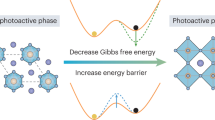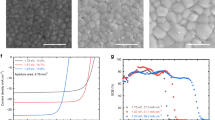Abstract
Perovskite/perovskite/silicon triple-junction solar cells offer notable potential for high power output at low cost, yet their development is hindered by the phase instability of perovskites, which limits both device reproducibility and performance. The ~1.50-eV formamidinium lead triiodide (FAPbI3)-based middle layer degrades during subsequent fabrication steps, and the ~2.0-eV bromide-rich top layer suffers from light-induced phase segregation. Here we address these challenges by introducing ammonium propionic acid to enhance the phase stability in both perovskite layers. This strategy raises the phase transition energy barrier and suppresses vacancy defect formation through additional bonding with lattice cations. These improvements mitigate phase instabilities and enhance the power conversion efficiency of devices based on the modified perovskite films. As a result, perovskite/perovskite/silicon triple-junction solar cells achieve a power conversion efficiency of 28.7% on a 1-cm2 aperture area, with substantially improved reproducibility.
This is a preview of subscription content, access via your institution
Access options
Access Nature and 54 other Nature Portfolio journals
Get Nature+, our best-value online-access subscription
$32.99 / 30 days
cancel any time
Subscribe to this journal
Receive 12 print issues and online access
$259.00 per year
only $21.58 per issue
Buy this article
- Purchase on SpringerLink
- Instant access to full article PDF
Prices may be subject to local taxes which are calculated during checkout




Similar content being viewed by others
Data availability
All data are available in the Article or Supplementary Information.
References
Rong, Y. et al. Challenges for commercializing perovskite solar cells. Science 361, eaat8235 (2018).
Li, Z. et al. Scalable fabrication of perovskite solar cells. Nat. Rev. Mater. 3, 18017 (2018).
Leijtens, T., Bush, K. A., Prasanna, R. & McGehee, M. D. Opportunities and challenges for tandem solar cells using metal halide perovskite semiconductors. Nat. Energy 3, 828–838 (2018).
Kim, J. Y., Lee, J.-W., Jung, H. S., Shin, H. & Park, N.-G. High-efficiency perovskite solar cells. Chem. Rev. 120, 7867–7918 (2020).
Aydin, E. et al. Pathways toward commercial perovskite/silicon tandem photovoltaics. Science 383, eadh3849 (2024).
Best research-cell efficiencies. NREL https://www.nrel.gov/pv/cell-efficiency.html (2023).
Rühle, S. Tabulated values of the Shockley–Queisser limit for single junction solar cells. Sol. Energy 130, 139–147 (2016).
Shockley, W. & Queisser, H. J. Detailed balance limit of efficiency of p-n junction solar cells. J. Appl. Phys. 32, 510–519 (1961).
Liu, J. et al. 28.2%-efficient, outdoor-stable perovskite/silicon tandem solar cell. Joule 5, 3169–3186 (2021).
Aydin, E. et al. Enhanced optoelectronic coupling for perovskite/silicon tandem solar cells. Nature 623, 732–738 (2023).
Al-Ashouri, A. et al. Monolithic perovskite/silicon tandem solar cell with > 29% efficiency by enhanced hole extraction. Science 370, 1300–1309 (2020).
Liu, J. et al. Efficient and stable perovskite-silicon tandem solar cells through contact displacement by MgFx. Science 377, 302–306 (2022).
Mariotti, S. et al. Interface engineering for high-performance, triple-halide perovskite–silicon tandem solar cells. Science 381, 63–69 (2023).
Chin, X. Y. et al. Interface passivation for 31.25%-efficient perovskite/silicon tandem solar cells. Science 381, 59–63 (2023).
Futscher, M. H. & Ehrler, B. Efficiency limit of perovskite/Si tandem solar cells. ACS Energy Lett. 1, 863–868 (2016).
Hörantner, M. T. et al. The potential of multijunction perovskite solar cells. ACS Energy Lett. 2, 2506–2513 (2017).
Boyd, C. C., Cheacharoen, R., Leijtens, T. & McGehee, M. D. Understanding degradation mechanisms and improving stability of perovskite photovoltaics. Chem. Rev. 119, 3418–3451 (2019).
Lee, J. & Park, N. Chemical approaches for stabilizing perovskite solar cells. Adv. Energy Mater. 10, 1903249 (2020).
Wang, R. et al. A review of perovskites solar cell stability. Adv. Funct. Mater. 29, 1808843 (2019).
Chen, T. et al. Entropy-driven structural transition and kinetic trapping in formamidinium lead iodide perovskite. Sci. Adv. 2, e1601650 (2016).
Liu, X. et al. Stabilization of photoactive phases for perovskite photovoltaics. Nat. Rev. Chem. 7, 462–479 (2023).
He, J. et al. Influence of phase transition on stability of perovskite solar cells under thermal cycling conditions. Sol. Energy 188, 312–317 (2019).
Sheikh, A. D. et al. Effects of high temperature and thermal cycling on the performance of perovskite solar cells: acceleration of charge recombination and deterioration of charge extraction. ACS Appl. Mater. Interfaces 9, 35018–35029 (2017).
Palmstrom, A. F. et al. Enabling flexible all-perovskite tandem solar cells. Joule 3, 2193–2204 (2019).
Johnson, S. A. et al. Improving the barrier properties of tin oxide in metal halide perovskite solar cells using ozone to enhance nucleation. Joule 7, 2873–2893 (2023).
Xu, F. et al. Monolithic perovskite/perovskite/silicon triple-junction solar cells with cation double displacement enabled 2.0 eV perovskites. Joule 8, 224–240 (2024).
Hultqvist, A. et al. SnOx atomic layer deposition on bare perovskite—an investigation of initial growth dynamics, interface chemistry, and solar cell performance. ACS Appl. Energy Mater. 4, 510–522 (2021).
Knight, A. J. & Herz, L. M. Preventing phase segregation in mixed-halide perovskites: a perspective. Energy Environ. Sci. 13, 2024–2046 (2020).
Slotcavage, D. J., Karunadasa, H. I. & McGehee, M. D. Light-induced phase segregation in halide-perovskite absorbers. ACS Energy Lett. 1, 1199–1205 (2016).
Barker, A. J. et al. Defect-assisted photoinduced halide segregation in mixed-halide perovskite thin films. ACS Energy Lett. 2, 1416–1424 (2017).
Knight, A. J. et al. Halide segregation in mixed-halide perovskites: influence of A-site cations. ACS Energy Lett. 6, 799–808 (2021).
Xiang, W., Liu, S. F. & Tress, W. A review on the stability of inorganic metal halide perovskites: challenges and opportunities for stable solar cells. Energy Environ. Sci. 14, 2090–2113 (2021).
Ono, L. K., Qi, Y. & Liu, S. F. Progress toward stable lead halide perovskite solar cells. Joule 2, 1961–1990 (2018).
Yao, D. et al. 2D–3D mixed organic–inorganic perovskite layers for solar cells with enhanced efficiency and stability induced by n-propylammonium iodide additives. ACS Appl. Mater. Interfaces 11, 29753–29764 (2019).
Lin, Y. et al. Enhanced thermal stability in perovskite solar cells by assembling 2D/3D stacking structures. J. Phys. Chem. Lett. 9, 654–658 (2018).
Li, H. et al. 2D/3D heterojunction engineering at the buried interface towards high-performance inverted methylammonium-free perovskite solar cells. Nat. Energy 8, 946–955 (2023).
Fei, C. et al. Self-assembled propylammonium cations at grain boundaries and the film surface to improve the efficiency and stability of perovskite solar cells. J. Mater. Chem. A 7, 23739–23746 (2019).
Zhang, Y. et al. Propylammonium chloride additive for efficient and stable FAPbI3 perovskite solar cells. Adv. Energy Mater. 11, 2102538 (2021).
Zheng, X. et al. Managing grains and interfaces via ligand anchoring enables 22.3%-efficiency inverted perovskite solar cells. Nat. Energy 5, 131–140 (2020).
Wang, R. et al. Caffeine improves the performance and thermal stability of perovskite solar cells. Joule 3, 1464–1477 (2019).
Wang, R. et al. Constructive molecular configurations for surface-defect passivation of perovskite photovoltaics. Science 366, 1509–1513 (2019).
Park, B. et al. Publisher correction: stabilization of formamidinium lead triiodide α-phase with isopropylammonium chloride for perovskite solar cells. Nat. Energy 6, 848 (2021).
Park, J. et al. Controlled growth of perovskite layers with volatile alkylammonium chlorides. Nature 616, 724–730 (2023).
Shi, P. et al. Oriented nucleation in formamidinium perovskite for photovoltaics. Nature 620, 323–327 (2023).
Acknowledgements
We acknowledge the use of the KAUST Solar Center and the support of its staff, and J. Xu is involved in the DFT discussion. Computing resources used in this work were provided by the National Center for High Performance Computing of Turkey (UHeM) under grant number 1015902023, supporting I.Y. and C.D. The KAUST team was supported by the KAUST Office of Sponsored Research (OSR) under award numbers URF/1/4350-01, URF/1/4669-01 and URF/1/5035-01.
Author information
Authors and Affiliations
Contributions
F.X. conceived the idea. F.X. and E.A. wrote the paper. F.X. developed all the 1-J and tandem solar cells, performed all the characterizations if not claimed specifically, and analysed all the data and performed all the calculations with the other co-authors. F.X. and J.L. performed the J–V and EQE measurements of 3-J solar cells and the transient photocurrent decay. I.Y. and C.D. performed the DFT calculations. E.U. conducted the QFLS measurement. L.X. performed the S–Q limit simulation. B.V. performed the STEM analysis. X.Z. conducted the XRD characterization. T.A. performed the SPICE simulations. A.R., T.A. and A. Pininti contributed to the Si bottom-cell fabrication. S.D.W. supervised the project and secured funding for this research. A. Prasetio. and A.S. contributed to the schematics and data analysis. M.M. contributed to the encapsulation of devices and stability measurement. All authors participated in the paper preparation.
Corresponding authors
Ethics declarations
Competing interests
The authors declare no competing interests.
Peer review
Peer review information
Nature Materials thanks Yi Hou, Christian Wolff and the other, anonymous, reviewer(s) for their contribution to the peer review of this work.
Additional information
Publisher’s note Springer Nature remains neutral with regard to jurisdictional claims in published maps and institutional affiliations.
Supplementary information
Supplementary Information
Supplementary Note, Figs. 1–29 and Table 1.
Rights and permissions
Springer Nature or its licensor (e.g. a society or other partner) holds exclusive rights to this article under a publishing agreement with the author(s) or other rightsholder(s); author self-archiving of the accepted manuscript version of this article is solely governed by the terms of such publishing agreement and applicable law.
About this article
Cite this article
Xu, F., Aydin, E., Yavuz, I. et al. Stabilized perovskite phases enabling efficient perovskite/perovskite/silicon triple-junction solar cells. Nat. Mater. (2025). https://doi.org/10.1038/s41563-025-02367-8
Received:
Accepted:
Published:
DOI: https://doi.org/10.1038/s41563-025-02367-8



